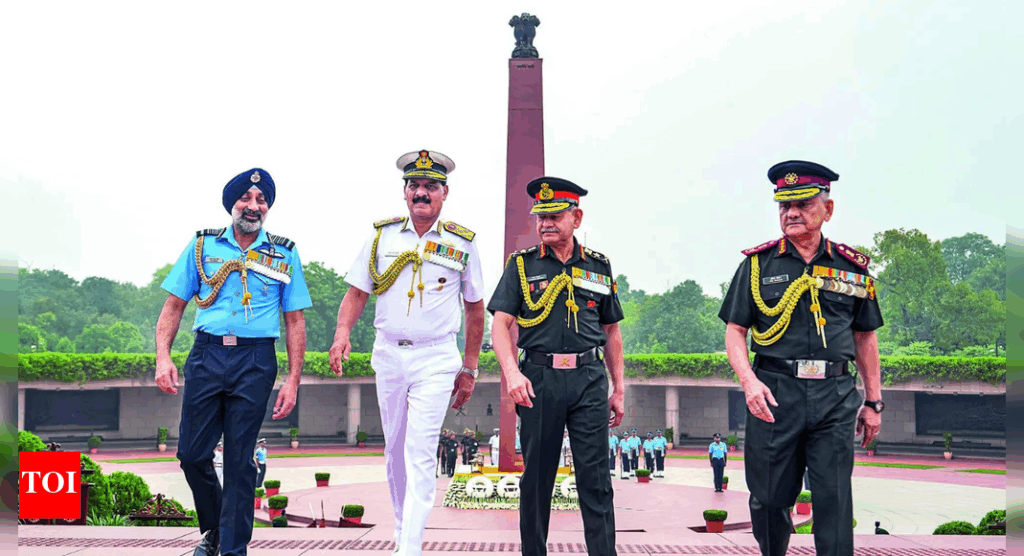
In a powerful demonstration of air power’s strategic impact, Air Chief Marshal A P Singh lauded the “bold and precise” attacks during Operation Sindoor, emphasizing their role in swiftly shaping military outcomes. Conducted from May 7 to 10, these precision strikes underscored the importance of offensive air action, showcasing the Indian Air Force’s (IAF) capability to target deep within enemy territory.
The announcement comes as the IAF celebrated its 93rd anniversary, with a grand parade at the Hindon airbase in New Delhi. Air Chief Marshal Singh, alongside naval chief Admiral Dinesh K Tripathi, army chief General Upendra Dwivedi, and Chief of Defence Staff General Anil Chauhan, highlighted the operation’s success in reaffirming the strategic value of air power.
Operation Sindoor: A Strategic Triumph
Operation Sindoor, involving cross-border hostilities, demonstrated the IAF’s ability to execute deep precision strikes, restoring the prominence of air power in national defense strategy. General Anil Chauhan praised the IAF’s consistent ability to influence strategic outcomes, citing the operation as a testament to the force’s precision and reach.
During the IAF Day celebrations, Air Chief Marshal Singh awarded 97 medals to air warriors and six unit citations, recognizing the exemplary performance of Rafale, Sukhoi-30MKI, and S-400 squadrons. He urged air warriors to remain vigilant and adaptable to future security challenges, emphasizing the need for innovative and practical planning.
Historical Context and Technological Advancements
The success of Operation Sindoor can be traced back to the IAF’s long history of strategic air operations. From the 1948, 1971, and 1999 wars to the 2019 Balakot airstrike, the IAF has consistently demonstrated its prowess in safeguarding national interests.
ACM Singh described Operation Sindoor as a “shining example” of meticulous planning and disciplined execution. He highlighted the robust air defense architecture and the effective use of long-range surface-to-air missile systems, which limited the adversary’s operational capabilities and protected vital assets.
“The outstanding performance of indigenously developed and integrated weapons, which delivered precise and devastating blows deep inside enemy territory, vindicates our faith in home-grown capabilities,” ACM Singh stated.
Future Challenges and Strategic Preparedness
Looking ahead, Air Chief Marshal Singh emphasized the importance of maintaining an “increased culture of accountability, safety, and security” within the force. He noted that this focus has directly contributed to a reduction in incidents and accidents, enhancing overall operational efficiency.
Moreover, the IAF’s role in Operation Sindhu, which facilitated the evacuation of Indians from conflict zones in Iran and Israel, further demonstrated its versatility and commitment to humanitarian missions.
Expert Opinions and Strategic Implications
Defense analysts have lauded Operation Sindoor as a pivotal moment for the IAF, highlighting the operation’s strategic implications. According to military expert Dr. Rakesh Sharma, “The precision and effectiveness of the strikes have set a new benchmark for air operations in the region.”
Furthermore, the operation has prompted discussions on the evolving nature of warfare and the critical role of air power in modern military strategy. As geopolitical tensions persist, the IAF’s ability to project power swiftly and decisively remains crucial.
Conclusion: A Forward-Looking Perspective
As the IAF continues to evolve, its focus on innovation, accountability, and strategic preparedness will be essential in addressing future security challenges. Operation Sindoor serves as a reminder of the transformative power of air operations and the IAF’s unwavering commitment to national defense.
The move represents a significant step forward in reinforcing the IAF’s strategic capabilities, ensuring that it remains a formidable force in safeguarding India’s sovereignty and interests.





